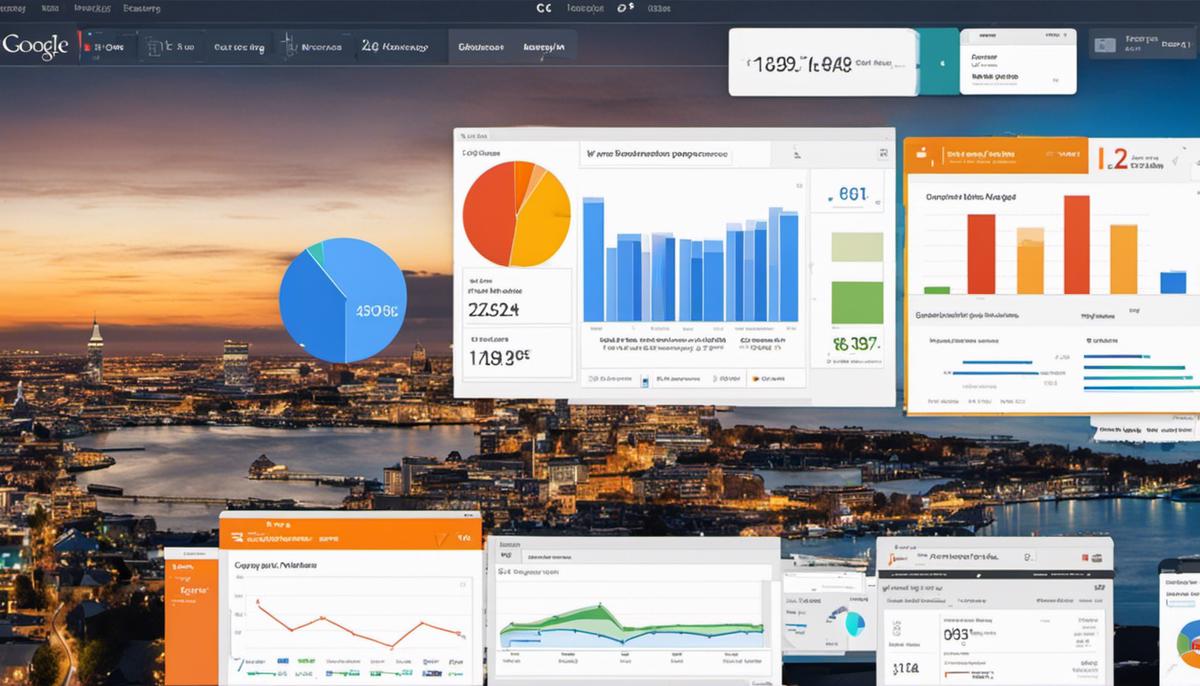How to get the most out of Google Analytics for your digital marketing efforts.
In this rapidly evolving digital age, no marketing strategy is complete without incorporating data-driven decisions. These decisions are often informed by digital analytics tools, of which Google Analytics remains a preferred choice, owing to its comprehensive features and user-friendly interface. Whether you are a novice just stepping into the digital marketing realm, or a seasoned marketer looking to drive more efficiency into your campaigns, understanding Google Analytics is absolutely essential. This write-up strewn across various sections will offer an in-depth look into the fundamentals of Google Analytics, guide you through setting it up, help you comprehend the various reports it generates and their implications, apply these insights to your digital marketing strategies, and finally delve into its more advanced features for augmenting your marketing efforts.
Fundamentals of Google Analytics
Understanding Google Analytics
Google Analytics is a free web analytics tool offered by Google, which tracks and reports website traffic. In terms of digital marketing, it provides valuable insights that can help you shape the success strategy of your business. By understanding Google Analytics, marketers can understand how their audience interacts with their website and content, helping them to make data-driven decisions.
Importance of Google Analytics in Digital Marketing
The primary advantage of Google Analytics in digital marketing is data accessibility – it provides marketers with a large quantity of data about their website’s performance. With the help of Google Analytics, marketers can understand how users are finding and interacting with their websites, what content they prefer, and how they behave once they’re there.
Google Analytics can also help track the efficiency of online marketing strategies, including SEO campaigns, social media marketing, and content marketing, allowing marketers to adjust their strategies based on this feedback to improve efficiency and optimize for better results.
How Google Analytics Works
Google Analytics collects data through a JavaScript code added to web pages. When a user visits a webpage embedded with this JavaScript code, the user’s browser sends a request to the Google Analytics server containing information about the user’s visit to the page. This includes information like the user’s location, the web page they visited, how long they spent on the page, and where they clicked. Google Analytics then organizes and presents this data in a readable, comprehensible format.
Key Terminologies in Google Analytics
- Users: These are people who have visited your website at least once within the date range you have selected.
- Sessions: These refer to the period that a user is actively engaged with your website.
- Bounce rate: This indicates the percentage of users who navigate away from your site after viewing only one page.
- Conversion: This is the completion of a predefined goal, like a purchase or a form submission.
Understanding the Google Analytics’ Dashboard
The dashboard is the first screen you’ll see when you log into Google Analytics. The dashboard can be customized but generally it provides a high-level overview of some of the industry-standard metrics. These include audience demographics, behaviour, conversions, real-time users, traffic sources, and content. Each section of the dashboard gives critical insights into different aspects of the website’s performance and user interaction.
In the realm of digital marketing, there’s no underestimating the significant role that Google Analytics plays. Leveraging its data leads to the creation of more precise and results-driven strategies and campaigns. Google Analytics provides insights into where website visitors are coming from, how they interact with your content, and which areas are performing well. This allows marketers to make informed decisions to steer their business goals in the right direction.

Setting Up Google Analytics
Getting Started with Google Analytics
Embarking on the journey to leveraging Google Analytics for digital marketing begins with setting up an account on the platform. You can do this by visiting the Google Analytics website and hitting the “Start for free” button. If you are the owner of a Google account already, you can readily use it for this purpose. If not, you’ll need to create a new one.
Adding a Property to the account
The ‘property’ in Google Analytics refers to the website or app that you want to track. To add a property, you need to navigate to the Admin section of your account. Here, you’ll find three columns: Account, Property, and View. Under the Property column, select ‘Create Property’ option. You will be asked to input information about your website or app including its name, its URL (for websites), or its App ID (for apps). After you have inputted these details, click the ‘Create’ button and Google Analytics will generate a unique tracking code for your property.
Setting Up a Reporting View
Setting up a reporting view is significant as it filters the data that appears in your reports, helping to keep them clean and relevant. You can create a new view by selecting ‘Create View’ under the View column in the Admin section. You can name the view based on your preference (for example, ‘All Website Data’), choose the reporting time zone, and save it. It’s also recommendable to create an unfiltered view that includes all your website or app data.
Inserting the Tracking Code Into Your Website
After the creation of the property, Google Analytics will provide a tracking code that needs to be inserted into your website. If you’re using a CMS like WordPress, you can use specific plugins that make this process easier. If you need to manually insert the code, it should be placed in the header of every page you want to track.
Configuring the tool
To conclude the setup process, there are few configurations that need to be made. First, you can set up ‘Goals’ under the View column in the Admin section. These could be specific actions you want users to take on your website or app. For instance, completing a purchase or filling out a contact form. Likewise, you can enable ‘Site Search’ if your website or app has a search functionality. This can give you insights into what your users are looking for. In the Property settings, you can link Google Analytics with other tools such as Google Ads and Search Console.
By initiating the following steps, you’ll enable Google Analytics to start functioning. It will facilitate the tracking of essential metrics and provide a more thorough understanding of your audience’s behavior. Subsequently, this will boost user engagement and allow you to fine-tune your digital marketing strategies for the improvement of your target audience’s experience.

Understanding Google Analytics Reports
Deciphering Google Analytics Reports
Google Analytics serves as an impactful instrument that generates a variety of report types, each one offering unique insights into users’ engagements with your digital material. Knowing how to maximize the use of this intelligence is a pivotal component in enhancing your digital marketing tactics.
Audience Reports
Audience reports provide comprehensive data about who your users are. This data includes demographic information, such as age, gender, and geographical location, as well as information about users’ interests, new vs. returning visitors, and behaviors. It also uncovers details about users’ devices and network and how they interact with your site or app. Utilizing these insights, marketers can target their campaigns more effectively.
Behavior Reports
Behavior reports help to understand how users interact with your site. It tells what content is most engaging for users, indicating what they’re searching for on your site, which pages they visit most often, and how much time they spend on each page. This information can be used to optimize your content and improve overall user experience.
Real-Time Reports
Real-time reports show what is happening on your site or app at any given moment. This includes the number of active users, their geographical locations, which pages they’re viewing, and their traffic sources. Real-time reports are extremely useful for monitoring the immediate impact of marketing campaigns or site updates.
Acquisition Reports
Acquisition reports illustrate how your users arrive at your site or app. These reports break down traffic sources into categories like organic search, direct, social, referral, display, and others. By analyzing acquisition reports, you can pinpoint which of your marketing efforts are most successful in driving traffic to your website.
Conversion Reports
Conversion reports in Google Analytics show your success with fulfilling your business objectives. Conversions can be set as monetary transactions, form completion, or any other actions profitable for your business. These reports help identify which marketing efforts not only attract visitors but effectively encourage them to complete desired activities.
Before diving deep into the utilization of Google Analytics in digital marketing, it’s essential to mention how crucial it is to comprehend the data presented in its reports. A major part of marketing is learning how to read and adjust your strategies according to these metrics. To truly harness the potential of Google Analytics, timely review and comparison of reports is mandatory. In doing so, you can make informed changes to your strategies. The key to successful digital marketing via Google Analytics hinges on this data-driven flexibility.

Applying Google Analytics to Digital Marketing
Immersing into Google Analytics for Digital Marketing
Google Analytics has established itself as an instrumental tool in the realm of digital marketing. The platform offers vital data regarding web traffic, user behavior, and the efficacy of marketing campaigns.
A primary utility of Google Analytics lies in identifying trends. Tracking user habits on the site enables one to discern trending content and successful marketing approaches. With a clear understanding of these trends, you can predict future behavior accurately. For instance, a sudden uptick in traffic to a specific blog post may hint at a rising interest in that topic. Armed with this knowledge, your marketing team can produce related content, drawing in more visitors and stimulating engagement.
In analyzing user behavior, Google Analytics plays a central role. It collects data about your users’ origins, what devices they use, and actions they take on your site. This information aids in discerning your audience’s driving factors, allowing you to meet their needs and preferences effectively. As an illustration, a considerable percentage of your audience might use mobile devices, suggesting the potential benefit of focusing on mobile optimization or app development.
Google Analytics also assists in enhancing website functionality. The platform identifies pages plagued with high exit or bounce rates, potentially indicating navigational difficulties, slow loading times, or lack of user interest. By rectifying these issues, your website can become more user-centric and expert at visitor retention.
For tracking marketing campaign progress, Google Analytics stands as a priceless tool. It enables you to see which campaigns are driving traffic, inducing conversions, and generating a positive return on investment. Understanding the successful campaigns allows you to better allocate your budget by increasing investment in these and reducing it in less successful ones.
In-depth, Google Analytics is a critical element of any digital marketing playbook. Its detailed data and metrics provide insight for decision-making, marketing enhancements, and ultimately, business development towards predetermined objectives. Irrespective of the industry or the size of a company, Google Analytics use can lead to noticeable enhancement in digital marketing results.

Photo by bash__profile on Unsplash
Advanced Features of Google Analytics
The Intrinsic Value of Google Analytics
Google Analytics continues to be a valuable resource for digital marketers owing to the detailed data it provides about website traffic, user behavior, and more. An advanced feature of particular note is goal setting. Goals, as defined by Google Analytics, are the successful completions of specific user activities, or conversions, contributing to business success. This feature enables marketers to measure specific user interactions on their website, be it form submissions, downloads, button clicks, or even purchases, which is invaluable in optimizing and tailoring marketing strategies.
Assigning a Financial Value
Each goal allows marketers to assign a financial value, creating a way to measure how much that conversion is worth to their business. The value can be consistent or could vary depending on the goal. By understanding which goals are most profitable, marketers can tailor their strategies to focus on those particular conversions.
Event Tracking
Furthering its advanced capabilities is Google Analytics’ event tracking. Event tracking enables you to measure how users interact with your content. This can provide valuable data about how people engage with your website or app. For instance, event tracking can show you every time a video is played, a link is clicked, or a form is submitted.
Defining and Tracking Events
Defining and tracking these events can provide a more granular view of user behavior, giving marketers the chance to optimize their strategies based on real user interactions. Instead of just looking at page views or overall traffic, you can analyze specific actions that users take while on your website.
Segment Creation
Another powerful way to use Google Analytics is through segment creation. This feature allows you to isolate and analyze subsets of your data. Instead of looking at the entire data set, you can create segments of your users based on specific criteria.
Analyzing User Behavior
For example, you could create a segment of users who visited a specific page on your site, or who came from a particular traffic source. By creating these segments, you can analyze in more detail how different groups of users behave and respond to your website or marketing campaigns.
Linking with Other Google Services
Lastly, one crucial aspect of maximizing the potential of Google Analytics is by linking it to other Google services like AdWord and Search Console. This interconnected approach harnesses the power of Google’s suite of tools, providing a more holistic view of your marketing efforts.
Unlocking Powerful Insights
Linking your Google Analytics with Google AdWords can unlock powerful insights about your paid advertising campaigns. You can track and analyze your AdWords data within Google Analytics, providing a thorough overview of how your ads are performing.
Connecting with Search Console
Connecting Google Analytics to Google’s Search Console allows you to view search query data, see which Google search queries drive traffic to your site, and understand how users interact with your site once they arrive via search. By having all of these data points available in one place, it makes it easier for marketers to gauge the efficacy of their strategies and campaigns.
Advanced Features of Google Analytics
These advanced features of Google Analytics – goal setting, event tracking, segment creation, and linking with other Google services – provide marketers with a deeper understanding of their website traffic and user behavior. By leveraging these tools, digital marketers can refine their strategies, improve their effectiveness, and enhance their understanding of their audience’s needs and behavior.

Mastering Google Analytics equips you with an unprecedented understanding of your online audience, their preferences, and behaviors, ultimately empowering your digital marketing campaigns to be more strategic, efficient, and successful. This powerful tool not just stops at providing broad audience insights but also enables you to drill down to every minute detail of your digital campaigns. From merely setting up an account to exploiting the advanced features, Google Analytics serves as your best companion in the ever-dynamic digital marketing landscape. It’s time to leverage Google Analytics for your digital marketing initiatives, as it stands as the cornerstone for all data-driven marketing strategies in the world today.



